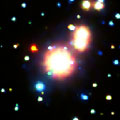An overview of the Chandra mission and goals, Chandra's namesake, top 10 facts.
Classroom activities, printable materials, interactive games & more.
Overview of X-ray Astronomy and X-ray sources: black holes to galaxy clusters.
All Chandra images released to the public listed by date & by category
Current Chandra press releases, status reports, interviews & biographies.
A collection of multimedia, illustrations & animations, a glossary, FAQ & more.
A collection of illustrations, animations and video.
Chandra discoveries in an audio/video format.
A Primer on Planet-forming Disks and Flares in Orion
May 10, 2005 ::
Scientists have recently used Chandra to observe powerful flares on
young Sun-like stars in the Orion Nebula. These
results show that solar flares may have played an important role in
shaping our solar system. Here, we explain more of the science behind
these conclusions and give some other details about these deep Chandra
observations.
How do we know there are disks around the young suns in Orion?
The strongest evidence for planet-forming disks in Orion comes from the
images of "proplyds" (short for "protoplanetary disks"). Some of the
proplyds in Orion are visible in optical light as disks in silhouette
against the
bright nebula. In some cases the
proplyds are being bombarded with energetic radiation from the brightest
stars in Orion, causing them to lose material in a bright, comet-like
tail. The Hubble Space Telescope (HST) has obtained dramatic
high-resolution images of both types of proplyd.
Infrared radiation can give strong but indirect evidence for the
presence of disks. Since disks are composed of gas and dust, and dust
glows at infrared wavelengths, young stars with unusually high infrared
radiation are often thought to have disks.
Among the 30 young Sun-like stars in Orion observed with Chandra, four are
associated with proplyds and thirteen show evidence for disks because of
excess infrared radiation.
What is the evidence that planets might form in these disks?
Although there is no direct evidence that planets are forming in the
Orion Nebula disks, there are compelling hints right here in our solar
system that disks are crucial for planet formation. All planets orbiting
the Sun, with the exception of Pluto, lie in an almost exactly flat
plane. The belt of comets outside of Neptune's orbit, known as the
Kuiper Belt, also lies in this plane. These are strong clues that the
planets were created from a disk, with the comets as disk debris.
There are other important links as well. For example, the Sun, like most
stars, is expected to have formed in a cluster like the Orion Nebula. This
shows that if planets survived the Sun's development in a cluster, they can
do so in Orion.
Also, the age of the stars in Orion is another piece of evidence. The
stars in Orion are young -- between about one and 10 million years.
Astronomers think planet-forming disks do not survive much longer than
10 million years. Therefore, stars and disks in Orion are the right age
for planets to be forming in Orion.
Indeed, Chandra observations of Orion may show indirect evidence for an
early stage of planet formation. The proplyds in the cluster are tilted by
different amounts with respect to Chandra's line of sight, with some viewed
nearly edge-on. In edge-on proplyds, the X-rays must pass through the
material in the disk to reach Chandra's detectors, and thus are a probe of
the gas in the disk. In at least one such case, the gas in the disk appears
to show a lack of metallic elements. These metals may have been locked up
into large dust grains, which is a necessary step in planet formation.
How large are the flares on the young suns in Orion?
X-ray flares on the young suns in Orion are much more powerful than the
strongest flares seen from the Sun today. One of the flares observed by
Chandra is thought to have extended out to almost 20 times the radius of
the star. With this super-flare, there may have been direct contact between
the inner part of the disk and the loop of the flare, a phenomenon that may
channel material from the disk onto the young star. By comparison, the
largest flares on mature stars like the Sun usually extend out to about one
solar radius, or about 20 times smaller than the giant flare seen in Orion.
What are some other possible effects of powerful X-ray flares from young stars?
Besides affecting planet formation, X-ray flares in the young Orion stars
may be able to solve long-standing mysteries about the composition of
ancient meteorites here in our own solar system. A mystery has surrounded
certain meteorites that contain an enormous number of flash-melted
chondrules (small, glassy spheres). Scientists have had a difficult time
explaining how these chondrules would have developed in a calm stellar
environment. Nor can they easily determine the origin of so-called calcium
and aluminum-rich inclusions (CAIs) also found in some meteorites.
The enormously powerful X-ray flares seen in Orion with Chandra might
provide the solution. Flares of this magnitude can create thermal
flashes or shock waves in the protoplanetary disk. This, in turn, could
have melted dustballs into chondrules or CAIs, which were eventually
swept up into meteorites. Thus, the Sun in its highly-energetic youth
may be responsible for some of the meteorite material we find today.
What are the other 1370 X-ray sources in Orion?
A few of the X-ray sources are massive stars, including Theta Ori C, a
star about 40 times more massive than the Sun and easily the brightest
X-ray source in Orion. However, most of the sources are stars that are
less massive than the Sun. The lightest of these are nine brown dwarfs,
objects with less than a tenth of the mass of the Sun which will never
become massive enough to begin hydrogen burning like the Sun.











